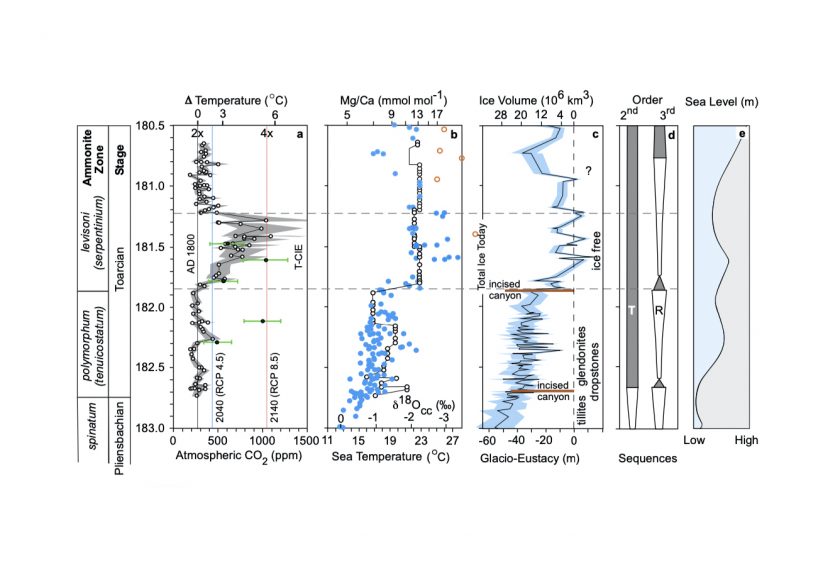Sea Level Changes from Global Warming in the Early Jurassic Not Analogous to Today’s
February 12, 2022
Reconstructing for the first time how global ice responded to atmospheric CO2 levels during a complete deglaciation of planet Earth, researchers from the University of Texas at Austin and Baylor University concluded that polar ice sheets do not always develop and recede in the pattern that we see today. The analysis, published last month in Nature Geoscience, demonstrates that Early Jurassic ice sheets were either thinner or extended closer toward the equator than today’s because the ice essentially melted at the same CO2 level at which it formed.

“Our results were eye-opening to me because, when we think of ice sheets, we think of modern Antarctica,” said co-author Daniel Breecker, professor in the Department of Geological Sciences at the Jackson School of Geoscience. “But our research shows that ice sheets may have been very different—with very different geometry—at times in the past.”
Despite substantial ice loss in today’s warming climate, the modern ice sheets in Antarctica are projected to persist to higher levels of atmospheric CO2 than the levels required to initiate their formation. This is because contemporary polar ice is very thick—sometimes miles thick— with much ice at cooler, higher altitudes that require a higher temperature than expected to trigger melting. The difference or lag between the threshold for formation of polar ice and melting of ice sheets is a type of hysteresis whereby the system behaves differently during cooling than it does during warming.
Warming climates are closely related to increased atmospheric CO2 levels which are recorded by the carbon isotope compositions of plants. Sea level change from melting/forming ice sheets affects the oxygen isotope ratios of sea water which can be observed in marine calcium carbonates (the fossil shells of ancient ocean-dwelling organisms). Both kinds of data were used in this study to show how sensitive sea level was to an ancient warming climate.
In order to utilize the most appropriate data, Breecker and colleagues sifted through the scientific literature and selected measurements from the western Tethys Sea (namely, Iberia, or Portugal and parts of Spain). The team used wood of one genus, Brachyoxylon, that lived in the humid, subtropical environments that more accurately estimate atmospheric CO2. In addition, because this marine locality was far from large rivers that dump fresh water into the sea, measurements of oxygen isotope ratios from these ancient marine sediments is more similar to what would have characterized the open ocean; the oxygen better-reflect the sea level or the amount of ice locked up in the ancient system.
“We went through a lot of effort to make sure that we were seeing an actual CO2 record,” said Breecker. “We used trees from humid environments only, and the data recording CO2 and ice volume were from the same rocks, allowing us to align those records with confidence.”
Breecker and colleagues found that, during the atmospheric warming of the early Jurassic—182.7 to 180.6 million years ago (mya)—ice sheets completely vanished when atmospheric CO2 reached a concentration between 600 to 700 ppm. But during this time period, ice also melted at lower concentrations of atmospheric CO2 like 400 ppm, similar to today’s atmospheric measurements. During the early Jurassic, there was barely any hysteresis (ice loss during warming and formation during cooling occurred at similar CO2 levels), leading to the conclusion that the early Jurassic’s ice sheets were very thin or extended toward the equator. Therefore, the Jurassic CO2-ice volume relationship cannot be used as a direct analogue for modern and future ice loss but it does improve our understanding of Earth’s climate system.
“Today, we are out of equilibrium between ice melting and what atmospheric CO2 suggests as a proxy for temperature. But at some point, the two will begin to equilibrate,” said lead author Lee Nordt, professor in the Department of Geosciences and Dean of the College of Arts & Sciences at Baylor University. “Our results show what happens over the long term with sustained high levels of CO2, although the ice sheets in the early Jurassic were smaller and probably thinner than today’s before melting in response to elevated CO2 began.”
In addition to Breecker and Nordt, the research was also conducted by co-author Joseph White, professor in the Department of Biology at Baylor University. Each author contributed equally to the paper.
Written by Kristin Phillips, Department of Geological Sciences